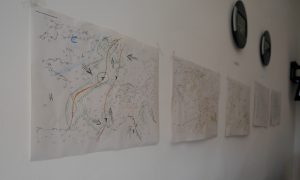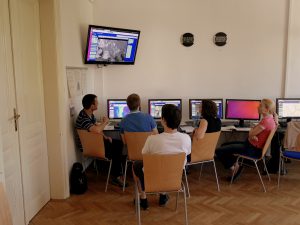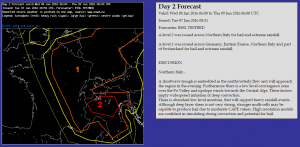Today we have started to prepare the first outlooks of the week. Therefore the participants were divided into two groups.
Group 1 was working on the day 1 outlook. They first started to make a surface analysis to diagnose the current distribution of low level moisture and the separation of warm and cool airmasses. In addition they were looking for convergence zones that might become interesting throughout the day. Although there have been quite a few differences the hotspots were anticipated by all surface analysis.
With the help of the soundings from 00 UTC it was also found out, that in the area of interest there was quite a good overlap of steep mid-level lapse rates and humidity. Whereas humidity was enhanced to the southwest, lapse rates became steeper to the northeast.
After that, the model output and the high-resolution ensembles have been studied to find out which regions will also stay under the influence of these good ingredients in the afternoon hours. The following map shows what the outlook at the end looked like.
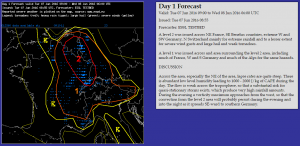
The main hazard is excessive precipitation due to the high humidity values in combination with almost non-existing storm motion. The lack of deep layer shear mostly prevents from big hail. However it cannot be excluded for local mesoscale developments. Also a local wet downburst cannot be ruled out given a somewhat larger spread in low-layer as seen in some of the 00 UTC soundings. Finally, having the almost non-existent flow in mid-level (850 to 500 hPa) and the development of local convergence zones it is also possible that we may see one or two tornados (landspouts).
What was in addition interesting is the approaching vorticity maximum from the west that is already visible in water vapor satellite images. This may lead to ongoing convection throughout the whole night.
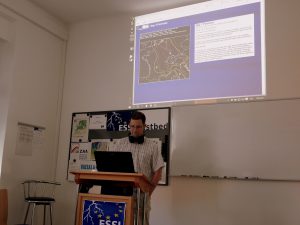
Short wave trough(s) are also interesting for our day 2 forecast. Since these features are accompanied with synoptic scale lift mechanisms that should enhance convective activity and in addition lead to better organized convection. Especially in the Po valley were the first short wave trough arrives in the afternoon hours also quite a lot of low level moisture will be present. Also the model output does enhance convective activity in that area. So this is why a LVL2 was issued in that region. The main threat again is excessive precipitation but also large hail is possible especially in the LVL2 area.
So … finally an interesting setup. Looking forward to the nowcasting session during the afternoon.


